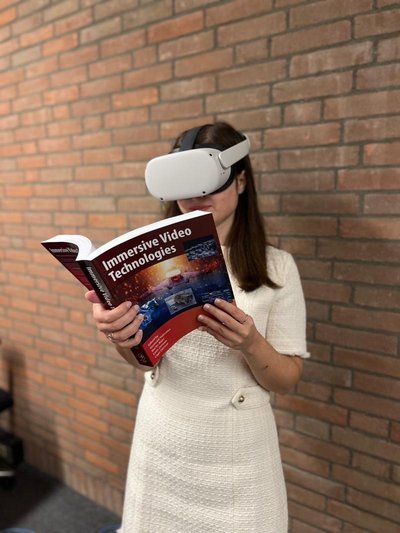
Video technologies have been evolving significantly and in many different directions over the last few decades, with the ultimate goal of providing a truly immersive experience to users. The idea is to give viewers a lifelike perspective. After setting up a common background for these technologies, based on the plenoptic function theoretical concept, the book Immersive Video Technologies offers a comprehensive overview of the leading technologies enabling visual immersion, including omnidirectional (360 degrees) video, light fields, and volumetric video.
Members of Distributed and Interactive Systems (DIS) have contributed 4 chapters to the book Immersive Video Technologies, edited by Giuseppe Valenzise, Martin Alain, Emin Zerman, and Cagri Ozcinar, and published in October 2022 by Elsevier. The book provides ‘a broad overview of the different modalities of immersive video technologies—from omnidirectional video to light fields and volumetric video—from a multimedia processing perspective’.
Streaming and user behavior
The contributions of DIS to the book span multiple topics: from streaming of omnidirectional videos, to volumetric video streaming, to visual quality assessment for volumetric content, to applications in social VR.
Silvia Rossi, now a postdoc in DIS, has authored the chapter ‘Streaming and user behavior in omnidirectional video’, along with Alan Guedes and Laura Toni. The chapter ‘provide[s] an overview of the research efforts that have been dedicated to advance omnidirectional videos streaming strategies, with a specific attention to the more recent human-centric systems’.
Volumetric video streaming
Irene Viola and Pablo César have authored the chapter ‘Volumetric video streaming’, in which they ‘discuss theoretical approaches to volumetric video streaming optimization, through compression solutions, as well as network and user adaptation, for high-end and low-powered devices’.
Quality assessment
Former DIS member Evangelos Alexiou, aided by Irene Viola and Pablo César, has authored the chapter ‘Subjective and objective quality assessment for volumetric video’, along with Yana Nehmé, Emin Zerman, Guillaume Lavoué, Ali Ak, Aljosa Smolic, and Patrick Le Callet. In the chapter ‘various aspects of VV quality assessment using subjective user studies and objective quality estimation methods are discussed. These aspects include the way of representing 3D models, mode of interaction, display settings (e.g., whether AR or VR headsets are used), rendering parameters, and how the characteristics of point clouds or meshes are used in quality estimation’.
Social virtual reality
Finally, former DIS member Jie Li, and Pablo César have authored the chapter ‘Social virtual reality (VR) applications and user experiences’. The chapter ‘introduces a few unique social VR applications, covering business areas such as healthcare, food, cultural heritage, and entertainment,’ demonstrating ‘the design and implementation process of the applications’, and ‘methods and protocols for evaluating user experiences in social VR’.

Valenzise, G., Alain, M., Zerman, E., and Ozcinar, C., Immersive video technologies. Elsevier.
